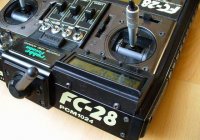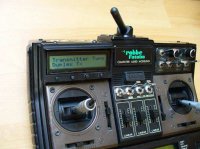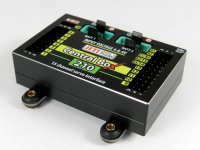The main advantages of Duplex system for common users definitely is a function of minimum transmitter power, automatic indication of the fault in backchannel communication, and recording of receiver power supply at the last flight. You might think that this is complicated but it definitely is not. The function of minimum transmitter power is very pleasant at the range test. You do not need a long walk for finding the fault at receiver antenna fixing or defective transmitter antenna. For safety reason activating of this function is acoustically indicated.
Here the difference between 35/40Mz and 2.4GHz bands is obvious At "35" uncontrolled automatic switch-on of the transmitter at full power would be a mistake, at 2.4GHz it is all right. Nobody is threatened and it is not possible to take off with minimum transmitter power. Taking advantage of another function, indication of backchannel communication loss, is not that unambiguous. This function activates acoustic signal in the transmitter in case the transmitter stops getting inspectional information or telemetric data from the receiver. Because transmitting power of the receiver (in the plane) is significantly lower than of the transmitter (of the module in the transmitter), backchannel communication is lost before the loss of the plane control. It means this function is able to warn us in advance of possible loss of the connection with the plane. I was interested in how long in advance before the complete loss of the signal this function is activated. At the tests I found out that it is approximately in the middle of the distance, thus early enough. I frequently faced the question: " Why does JETI model have 16 channel transmitter modules while there are only 8 channels in PPM mode in my transmitter...." It corresponds with the possibility of serial connection of transmitters and perpetual problem of large models - lack of control channels. Here are some examples of use.
1st example:
We have traing twin-boom single-motor plane with following channels distribution.
- mix channels 1 and 5 for controlling the ailerons
- mix channels 2 and 6 for controlling the elevator, servos are doubled for safety reasons
- channel 3 motor
- mix channels 4 and 7 for controlling two rudders (these are connected via Y cable to save channels) and front undercarriage (undercarriage in the mix because of trimming)
- channel 8 for flabs, again connected via Y cables
It is not possible to save more channels and because I have only 8 channels available, I miss channels for:
- undercarriage retraction
- undercarriage breaks
- emergency safety shutdown of the turbines
- if there is no need of saving the channels, I would divide rudders in two channels and they can also be used as air brakes
Thus I miss 4 channels with my 8 channel set and I will have to do without it or connect some functions in one channel in a complicated way.
2nd example
Now let´s try the same situation with the same model and the same transmitter, the only change is using JETI Duplex transmitter module and two 8 channel receivers connected in series in the plane.
- mix channels 1 and 9 for controlling the ailerons
- mix channels 2 and 10 for controlling the elevator, servos are doubled for safety reasons
- channel 3 motor
- mix channels 4 and 11 for controlling two rudders (these are connected via Y cable to save channels) and front undercarriage (undercarriage in the mix because of trimming)
- channel 8 flabs, again connected via Y cables
- channel 5 for undercarriage retraction
- channel 6 for undercarriage breakes
- channel 7 for emergency safety shutdown of the turbines
And the result? All the needed functions are controlled and there are still vacant positions 12, 13, 14, 15, and 16 in the transmitter. Though these cannot be used for direct controlling of the plane, they can still be mixed with any other channel. It is rather interesting, but nothing is faultless. It is possible only if channels 9 - 16 are used for mixed functions and instead of mixes in the transmitter the JETI ones are used. Sacrifying transmitter mixes is not that serious problem. In one hand because mixes can be set easily via JETI box directly form the transmitter, secondly because the possibilities and functions available in JETI program are at least as good and complete as the program in Futaba FC 28.
 |
 |
And finally some most freqent questions and opinions I have faced so far. For example the opinion that exchangeable modules 2.4GHz are only a substitute solution. I do not agree with that. Thanks to 2.4GHz modules, classic RC set is not only shifted one level higher, but it also enlarges its possibilities and substantially improves safety. Argument of hard-core "futabists" and "FASSTs" about 8 channels has already been sufficiently explained above. Another frequent objection: "Why to program a receiver? That´s why we have a trasnmitter..."
Perhaps because programming possibilities of JETI are at the level of higher class transmitter and it enlarges the possibilities of transmitters with more simple programs. Moreover the receiver can be set via JETI Box, both in the plane and from the transmitter. If the program is put just in the receiver, there is no need of switching models saved in the memory and thus they cannot be altered accidentally. Just for the reasons of testing and setting an example, I put JETI module in the driver of a flying simulator. Disregarding the quality of quad sticks, it makes 7 channel set operating in 2.4GHz band with wider possibilities of programming than at most transmitters on the market. To show versatility of JETI Duplex modules see the photos above.



















